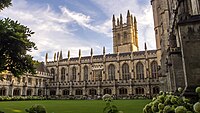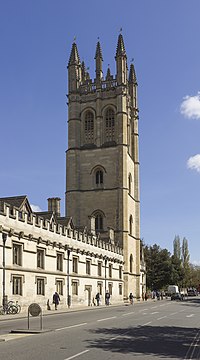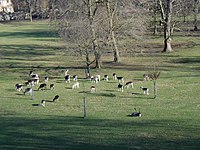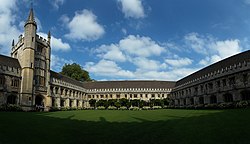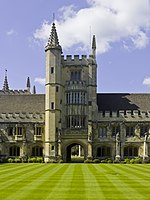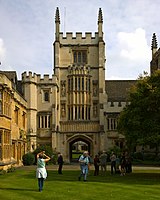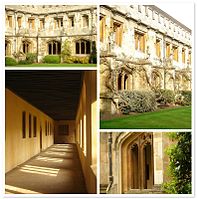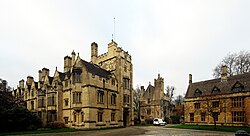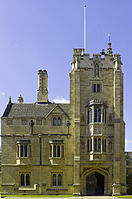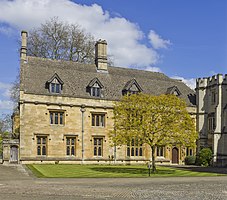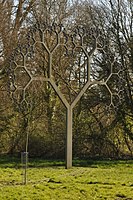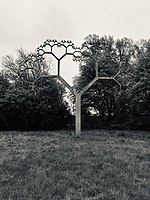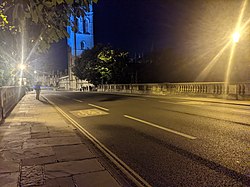Difference between revisions of "Magdalen College, Oxford"
(Created page with "{{Infobox college |name=Magdalen College |full name=The College of St Mary Magdalen in the University of Oxford |county=Oxfordshire |university=Oxford |city=Oxford |picture=Ma...") |
(No difference)
|
Latest revision as of 23:12, 15 March 2024
| Magdalen College Latin: Collegium Beatae Mariae Magdalenae
| |||||||||||
|
Floreat Magdalena | |||||||||||
|---|---|---|---|---|---|---|---|---|---|---|---|
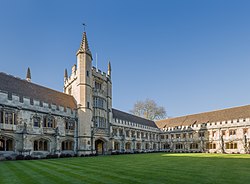 The Cloister and Founders’ Tower | |||||||||||
| President: | Dinah Rose KC | ||||||||||
| Website: | www.magd.ox.ac.uk | ||||||||||
| |||||||||||
| Location | |||||||||||
| Grid reference: | SP52070623 | ||||||||||
| Location: | 51°45’9"N, 1°14’49"W | ||||||||||
Magdalen College is a constituent college of the University of Oxford. It was founded in 1458 by Bishop of Winchester William of Waynflete.[1] It is one of the wealthiest Oxford colleges, as of 2022,[2] and one of the strongest academically, setting the record for the highest Norrington Score in 2010 and topping the table twice since then.[3] It is home to several of the university's distinguished chairs, including the Serena Professorship of Italian, the Sherardian Professorship of Botany, and the four Waynflete Professorships.
The large, square Magdalen Tower is an Oxford landmark, and it is a tradition, dating to the days of Henry VII, that the college choir sings from the top of it at 6 a.m. on May Morning.[4]
The college stands next to the River Cherwell and the University of Oxford Botanic Garden. Within its grounds are a deer park and Addison's Walk.
History
Foundation
Magdalen College was founded in 1458 by William of Waynflete, Bishop of Winchester and Lord Chancellor of England[1] and named after St Mary Magdalene. The college succeeded a university hall called 'Magdalen Hall', founded by Waynflete in 1448, and from which the college drew most of its earliest scholars.[5] Magdalen Hall was suppressed when the college was founded. The name was revived for a second Magdalen Hall, established in the college's grounds around 1490, which in the 19th century was moved to Catte Street and eventually became Hertford College.[6][7]
Waynflete also established a school, now Magdalen College School, a private school located nearby on the other side of the Cherwell. Waynflete was assisted by a large bequest from Sir John Fastolf, who wished to fund a religious college.[8]
Magdalen College took over the site of St John the Baptist Hospital, alongside the Cherwell, initially using the hospital's buildings until new construction was completed between 1470 and 1480.[9] At incorporation in 1458, the college consisted of a president and six scholars. In 1487 when the Founder's Statutes were written, the foundation consisted of a President, 40 fellows, 30 demies, four chaplain priests, eight clerks, 16 choristers, and appointed to the Grammar School, a Master and an usher.[5]
The founder's statutes included provision for a choral foundation of men and boys (a tradition that has continued to the present day) and made reference to the pronunciation of the name of the college in English. The college's name is pronounced like the adjective 'maudlin' because the late mediæval English name of Mary Magdalene was Maudelen, derived from the Old French Madelaine.[10]
Civil War
Oxford and Magdalen College were supporters of the Royalist cause during the Civil War. In 1642, Magdalen College donated over 296 lbs of plate (ie. silver or gold utensils or dishes) to fund the war effort – the largest donation by weight of any Oxford college.[11]
Magdalen College, commanding a position on the banks of the Cherwell that overlooked Magdalen Bridge and the road from London, had tactical significance for the King's forces. From 1643 to 1645, Magdalen's Grove was occupied by the Royalist ordnance, and Prince Rupert is thought to have quartered in the college.[12][5]
The city built fortifications in preparation for siege through Magdalen's grounds, including Dover's Speare (or Pier), a bastion that would have allowed observation to the north and east of the city. The earthworks where it was located, in the Water Meadow where the Cherwell forks, are still apparent today.[12] Further fortifications and earthworks were built to protect the Holywell Ford site to the north.[13]
During the first Siege of Oxford, King Charles I surveyed the battle from Magdalen Tower.[14]
Following the capitulation of Oxford to Thomas Fairfax at the end of the First Civil War, Parliament ordered a Visitation to Oxford to purge Fellows for political and religious reasons. In 1647, the Visitors removed the then-president of Magdalen John Oliver and appointed instead one of their number, John Wilkinson, a former Principal of Magdalen Hall who had previously run unsuccessfully for the position of President at the college. When they refused to submit to the authority of Parliament, around 28 of the fellows, 21 of the demies (scholars), and all but one of the servants were also expelled. With the Royalists finally removed, the college would host Fairfax and Oliver Cromwell in 1649.[5]
After the Restoration of the monarchy in 1660 John Oliver was reappointed to the college, followed by 17 fellows and eight demies.[5]
Expulsion of the Fellows
During the 1680s, King James II made several moves to reintroduce Roman Catholicism into the then Anglican university.[15] In 1687, he attempted to install Anthony Farmer as President of Magdalen. The fellows rejected this, not just because Farmer was reputedly a Romanist and had a tarnished reputation, but also as he was not a fellow of the college, and therefore ineligible under the statutes.[15][5] The fellows elected instead one of their own John Hough. James eventually offered a compromise candidate in the form of the moderate Bishop of Oxford, Samuel Parker,[15] but he too was rejected by the fellows as they considered the role filled.[16]
Parker was admitted by force[5] and the fellows and demies who had defied the king were expelled, replaced by the king's choice of Papists or moderate Anglicans. Parker died in 1688 and was replaced by Bonaventure Giffard, a Roman Catholic under whose tenure the Chapel converted to the Roman religion.[15]
The expulsion of the fellows marked a turning point in the university's relationship with the Crown: Brockliss writes, "the royalist and Anglican University established at the Restoration had had to make a choice and it had chosen Anglicanism."[15] James' interference with the college fed resentment in Anglicans who used it as evidence that his rule was autocratic.[15] On 25 October 1688, shortly before the Glorious Revolution and overthrow of James II by William of Orange, James' appointments were reversed and Hough and the expelled fellows were restored to the college.[15] This event is marked every year at a special banquet, the Restoration Dinner, for Magdalen fellows, demies, and academic clerks.
20th–21st centuries
Magdalen's prominence since the mid-20th century owes much to such famous fellows as C. S. Lewis and A. J. P. Taylor, and its academic success to the work of such dons as Thomas Dewar Weldon.[17] During Second World War, RAF Maintenance Command was headquartered at Magdalen.[18]
Magdalen College owns and manages the Oxford Science Park to the south of Oxford, a science and technology park home to over 100 companies. The Oxford Science Park opened in 1991, with Magdalen as part owner. The college acquired total ownership in 2016,[19][20] before selling 40% of its stake in 2021 for £160 million.[21] It was reported that this sale will more than double the size of Magdalen's endowment fund, and make it "probably the richest of Oxford's 39 colleges".[22]
Like many of Oxford's colleges, Magdalen admitted its first mixed-sex cohort in 1979, after more than half a millennium as a men-only institution.[1]
Buildings
The college grounds stretch north and east from the college, and include most of the area bounded by Longwall Street, the High Street (where the porter's lodge is located), and St Clement's. The college features a variety of architectural styles, and has been described as "a mediæval nucleus with two incomplete additions, one from the eighteenth and one from the nineteenth century".[23]
The college is organised around five quads. The irregularly shaped St John's Quad is the first on entering the college, and includes the Outdoor Pulpit and old Grammar Hall. It connects to the Great Quad (the Cloister) by way of the Perpendicular Gothic Founders Tower, which is richly decorated with carvings and pinnacles and has carved bosses in its vault. The Chaplain's Quad runs along the side of the Chapel and Hall, to the foot of the Great Tower. St Swithun's Quad and Longwall Quad (which contains the Library) date from the late 19th and early 20th centuries, and make up the south-west corner of the college.
Original buildings
The college is built on the site of St John the Baptist Hospital, which was dissolved in 1457 and its property granted to William of Waynflete.[9] Some of the hospital buildings were reused by the college, and the kitchens survive today as the college bar, the Old Kitchen Bar.[5][24]
New construction began in 1470 with the erection of a wall around the site by mason William Orchard. Following this, Orchard also worked on the chapel, hall, and the cloister, including the Muniment and Founder's Towers, with work completed around 1480.[5]
Cloister
The Cloister or Great Quad is the "mediæval nucleus" of the college. It was constructed between 1474 and 1480, also by Orchard, although several modifications were made later. Access to the Cloister from St John's Quad is by way of the Founder's Tower or Muniment Tower. The chapel and the hall make up the southern side of the quad. It is also home to the junior, middle, and senior common rooms, and the old library.
In 1508, grotesques known as hieroglyphics were added to the Cloister. These are thought to be allegorical, and include four hieroglyphics in front of the old library that represent scholarly subjects: science, medicine, law, and theology.[25][26] The other hieroglyphics have been assigned symbolism relating to virtues that should be encouraged by the college (e.g. the lion and pelican grotesques in front of the Senior Common Room representing courage and parental affection) or vices that should be avoided (the manticore, boxers, and lamia in front of the Junior Common Room, representing pride, contention, and lust).[26] In 2017, repair work was undertaken to restore the severely damaged boxers statue.[27]
In 1822, the north side of the Cloister was knocked down, ostensibly due to disrepair. This decision was controversial, provoking protests from the fellows and in the contemporary press, and it was rebuilt shortly afterwards.[23][5]
In the early 1900s, renovations were performed, and it was returned to a more mediæval character. Student rooms were installed in the (very large) roof space in the 1980s.
Chapel
The chapel is a place of worship for members of the college and others in the University of Oxford community and beyond. As a High Anglican chapel, its tradition is influenced by the Counter-Reformation in the Church of England. Said and sung services are held daily during term.[28] The choir sings Choral Evensong or Evening Prayer every day at 6:00 pm except on Mondays.[28] On Sundays, a Sung Eucharist is offered in the morning at 11:00 am. Compline (Night Prayer) is sung once each week, and is followed by a service of Benediction twice per term.[28] Mass is also sung on major holy days.[28][29]
The chapel itself is a grade I listed building. It was built between 1474 and 1480,[30] although it owes its present appearance largely to neo-Gothic works carried out in the 18th and 19th centuries.
The roof, giving the impression of a stone vaulted ceiling, is in fact a facsimile made from plaster added in 1790 by neo-Gothic architect James Wyatt. Wyatt's redevelopment of the chapel included a number of modifications to make it more Gothic in character, but other than the ceiling, Wyatt's contributions were removed during a later redesign in 1828.[30][23][31]
Magdalen Tower
- Main article: Magdalen Tower
Construction of Magdalen's Great Tower began in 1492 by another mason, William Raynold. It might have been intended to replace an existing belfry remaining from the hospital, and probably was originally envisioned to stand alone. By the time it was completed in 1509, additional buildings had been built either side, creating the roughly triangular Chaplain's quad between the chapel and the High.[5]
The tower contains a peal of ten bells hung for change ringing. They were cast at a number of different foundries and the heaviest, weighing 17 cwt, was cast in 1623.[32]
The tower is 144 feet tall and an imposing landmark on the eastern approaches to the city centre. It forms the centre of the May Morning celebrations in Oxford, from which the choir sing pieces including the Hymnus Eucharisticus and the Dean of Divinity blesses the University, city, and crowds.[4]
The New Building
During the 18th and 19th centuries, there were numerous attempts made to redesign the site to better suit the college's needs.[23] The New Building began construction in 1733 as a part of Edward Holdsworth's designs from 1731. It is built in a Palladian style, and features a colonnade.[23]
It was conceived as one side of a new "Great Quadrangle", and in anticipation of this the building's ends had been left unfinished. However, Holdsworth's full vision was never completed. The idea was revisited several times by later architects, including by architects James Wyatt—whose plans (never realised) included partially demolishing the existing, Mediæval quad (the Cloister) and refinishing the neoclassical New Building in a Georgian Gothic style—and John Buckler.[23][31] In the 19th century, John Nash and Humphrey Repton both submitted designs for new, open quadrangles that incorporated the New Building.[23]
Ultimately, the idea of integrating the New Building into a new quad was abandoned, and the ends of the building were finally completed in 1824 with two returns designed by Thomas Harrison.[23] Today, it stands apart from the Cloister, overlooking four croquet lawns on one side and the Grove deer park on the other. It is used for accommodation for undergraduates and fellows, including historically Edward Gibbon and C. S. Lewis, and also houses the wine cellar.[33]
Libraries
In addition to the university's central and departmental libraries, Oxford's colleges maintain their own libraries. The original college library, the Old Library, is located in the Cloister and accessed via Founder's Tower or the President's Lodgings. It contains a large collection of manuscripts from before the 19th century. Consultation of material is typically by appointment, although the Old Library itself may be visited by the public during certain exhibitions.[34][35]
In 1931, the New Library, now called the Longwall Library, was established in the former College School building in Longwall Quad and became the college's main library for students. It was opened by Edward VIII when he was a student at Magdalen.[36] It was renovated between 2014 and 2016 by Wright & Wright Architects and reopened by Prince William, Duke of Cambridge.[37][36]
In addition, the college maintains the Denning Law Library in the Grove building, a reference library for Magdalen's law students, and the specialist Daubeny and McFarlane collections of 19th century scientific works and mediæval history works respectively. Items from the Daubeny and McFarlane libraries may be brought to the Longwall Library for consultation on request.[34]
Grounds
The Grove
The Grove or deer park is a large meadow which occupies most of the north-west of the college's grounds, from the New Building and the Grove Buildings to Holywell Ford. During the winter and spring, it is the home of a herd of fallow deer. It is possible to view the meadow and the deer from the path between New Buildings and Grove Quad, and also from the archway in New Buildings.
In the 16th Century, as recorded in a map from 1578, the Grove consisted of formal enclosed gardens, tree-lined avenues, an orchard, and a fish pond. By 1630, a bowling green had replaced the orchard.[12]
During the Civil War, between 1642 and 1645, the Grove became home to the workshops, forges, and foundries of Royal Ordinance. Following this, the landscaping began to transition from formal gardens to more natural parkland, and the water walks were landscaped. Deer began being cultivated in the college by at least the 1720s, and by the early 19th century the formal gardens had completely disappeared and college Fellow Dr Bloxham noted that the entire Grove had been given over to the deer.[12]
At one point in the 19th century it held three traction engines belonging to the works department of the college. By the 20th century it had become well-wooded with many large trees, but most of them were lost to Dutch elm disease in the 1970s.
Water meadow and Addison's Walk
The water meadow is a flood-meadow to the eastern side of the college, bounded on all sides by the Cherwell. In wet winters, some or all of the meadow may flood, as the meadow is lower lying than the surrounding path. All around the edge of the meadow is a tree-lined path, Addison's Walk, named for the fellow Joseph Addison (1672–1719), which connects to Holywell Ford and the Fellows' Garden.[38]
Addison's Walk is popular with College members and visitors. C. S. Lewis wrote a poem about the walk, Chanson d'Aventure or What the Bird Said Early in the Year, which is commemorated on a plaque near the gate to Holywell Ford.[38][39][40]
Thanks to the frequent flooding, the meadow is one of the few places in Britain that the snake's head fritillary, Fritillaria meleagris, may be seen growing wild.[41] These flowers grow in very few places, and have been recorded growing in the meadow since around 1785.[41] Once the flowering has finished, the deer herd is moved in for the summer and autumn.
Bat Willow meadow and the Fellows' Garden
Further east of the water meadow are Bat Willow meadow and the Fellows' Garden. They are separated from the water meadow and each other by other branches of the Cherwell, and may be accessed from Addison's Walk. Bat Willow meadow features Y, a 10 metre high sculpture of a branching tree by Mark Wallinger, commissioned for the college's 550th anniversary in 2008.[42][43] Due to their age and infection with honey fungus, the willow trees were cut down in 2018 and replanted, and the wood used to make cricket bats.[44]
The Fellows' Garden is located further north along the bank of the Cherwell than Bat Willow meadow, directly behind the Oxford Centre for Islamic Studies. This long and narrow garden follows the Cherwell to the edge of the University Parks. Further north is Magdalen's sports ground.
Pictures
| ("Wikimedia Commons" has material about Magdalen College, Oxford) |
View of the Great Tower from the Daubeny Laboratory, across the High.
Outside links
References
- ↑ 1.0 1.1 1.2 "College History". magd.ox.ac.uk. http://www.magd.ox.ac.uk/discover-magdalen/history-of-college.
- ↑ "Magdalen College : Report and Financial Statements for the Year Ended 31 July 2022". p. 27. http://d307gmaoxpdmsg.cloudfront.net/collegeaccounts2122/Magdalen.pdf.
- ↑ "Undergraduate Degree Classifications | University of Oxford". http://www.ox.ac.uk/about/facts-and-figures/undergraduate-degree-classifications.
- ↑ 4.0 4.1 Dunton, Larkin (1896). The World and Its People. Silver, Burdett. p. 55.
- ↑ 5.00 5.01 5.02 5.03 5.04 5.05 5.06 5.07 5.08 5.09 5.10 "Magdalen College", in A History of the County of Oxford: Volume 3, the University of Oxford, ed. H. E. Salter and Mary D. Lobel (London, 1954), pp. 193–207. British History Online http://www.british-history.ac.uk/vch/oxon/vol3/pp193-207 [accessed 5 February 2020].
- ↑ "Magdalen Hall". magd.ox.ac.uk. http://www.magd.ox.ac.uk/libraries-and-archives/archives/magdalen-hall/.
- ↑ Brockliss, Lawrence W. B. (2016). The University of Oxford: A History. Oxford University Press. p. 85. ISBN 978-0-19-924356-3.
- ↑ Rose, Jonathan (2003). "Memorandum Quod: John Fastolf and the Founding of Magdalen College". Magdalen College Record: 98–105.
- ↑ 9.0 9.1 'Hospitals: St John the Baptist, Oxford', in A History of the County of Oxford: Volume 2, ed. William Page (London, 1907), pp. 158–159. British History Online http://www.british-history.ac.uk/vch/oxon/vol2/pp158-159 [accessed 5 February 2020].
- ↑ "Maudlin (adj.)". Online Etymology Dictionary. https://www.etymonline.com/word/maudlin.
- ↑ Campbell, Marian (2003). "7. Mediæval Founders' Relics: Royal and Episcopal Patronage at Oxford and Cambridge Colleges". in Coss, Peter R.; Keen, Maurice. Heraldry, Pageantry and Social Display in Mediæval England. Boydell Press.
- ↑ 12.0 12.1 12.2 12.3 Steane, John (1998). "The Grounds of Magdalen College 1480—1880.". Oxoniensia LXIII: 91–104. https://www.oxoniensia.org/volumes/1998/steane.pdf.
- ↑ Bell, Christopher (1996). "Archaeological Investigations on the Site of a Mediæval and Post-Mediæval Watermill at Holywell Ford, Magdalen College, Oxford". Oxoniensia LXI: 275–295. https://www.oxoniensia.org/volumes/1996/bell.pdf.
- ↑ Walker, Sir Edward (1705). Historical Discourses, Upon Several Occasions. London. pp. 16–21. https://books.google.com/books?id=d-ExAQAAMAAJ&pg=PA16.
- ↑ 15.0 15.1 15.2 15.3 15.4 15.5 15.6 Brockliss, Lawrence W. B. (2016). The University of Oxford: A History. Oxford University Press. pp. 208–210. ISBN 978-0-19-924356-3.
- ↑ Corrie, George Elwes (1839). Brief Historical Notices of the Interference of the Crown with the Affairs of the English Universities. J. & J. J. Deighton. pp. 70–85.
- ↑ R.W. Johnson, Look Back in Laughter: Oxford's Postwar Golden Age, Threshold Press, 2015.
- ↑ "Colleges - Soldiers of Oxfordshire". http://www.sofo.org.uk/colleges.
- ↑ "Our Story". Oxford Science Park. https://oxfordsp.com/our-story/.
- ↑ "Magdalen Acquires 100% of Oxford Science Park". Magdalen College (Magdalen College, Oxford). 12 January 2016. https://www.magd.ox.ac.uk/news/magdalen-acquires-100-of-oxford-science-park/.
- ↑ "Magdalen College sells 40% of oxford Science Park to Singapore fund". Financial Times. 5 October 2021. https://www.ft.com/content/aba93c94-fb02-4ef6-9b34-5181ad99632b.
- ↑ "Oxford college's wealth boost exposes academia's haves and have-nots". The Guardian. 9 October 2021. https://www.theguardian.com/business/2021/oct/09/oxford-colleges-wealth-boost-exposes-academia-haves-have-nots.
- ↑ 23.0 23.1 23.2 23.3 23.4 23.5 23.6 23.7 Colvin, Sir Howard (1983). "VII Indecision at Magdalen". Unbuilt Oxford. Yale University Press. pp. 78-104. ISBN 0-300-03126-2. https://archive.org/details/unbuiltoxford0000colv/page/78.
- ↑ "Old Kitchen Bar". Magdalen College, Oxford. https://www.magd.ox.ac.uk/conferences/old-kitchen-bar/.
- ↑ Library Hieroglyphics, Magdalen College, Oxford, 29 July 2016, https://www.magd.ox.ac.uk/libraries-and-archives/treasure-of-the-month/news/library-hieroglyphics/
- ↑ 26.0 26.1 Slatter, H (1834). The Oxford University and City Guide. pp. 32–33. https://books.google.com/books?id=aSRbAAAAcAAJ&q=magdalen+cloister+boxers.
- ↑ "Boxers Statue, Magdalen College Oxford". https://www.alexwenham.co.uk/boxers-statue-magdalen-college-oxford/.
- ↑ 28.0 28.1 28.2 28.3 "Chapel Services". Magdalen College, Oxford. http://www.magd.ox.ac.uk/chapel-and-choir/services.
- ↑ "Chapel & Choir". Magdalen College, Oxford. http://www.magd.ox.ac.uk/chapel-and-choir.
- ↑ 30.0 30.1 National Heritage List 1369672: Magdalen College, Chapel, Great Quadrangle (Grade II listing)
- ↑ 31.0 31.1 Lindfield, Peter (2016). Georgian Gothic: Mediævalist Architecture, Furniture and Interiors, 1730–1840. Boydell & Brewer. pp. 168–169. ISBN 9781783271276.
- ↑ Magdalen College Bells, Dove's Guide for Church Bell Ringers.
- ↑ "As an Undergraduate". Magdalen College, Oxford. https://www.magd.ox.ac.uk/living-here/undergraduate-living-here/.
- ↑ 34.0 34.1 "Magdalen's Libraries". https://www.magd.ox.ac.uk/libraries-and-archives/libraries/.
- ↑ "New exhibition opening in September: "Women and Power? A Magdalen Story"". https://www.magd.ox.ac.uk/libraries-and-archives/news/new-exhibition-opening-in-september-women-and-power-a-magdalen-story/.
- ↑ 36.0 36.1 Rayner, Gordon (11 May 2016). "Prince William follows in Edward VIII's footsteps by opening new library at Oxford's Magdalen College". The Telegraph. https://www.telegraph.co.uk/news/2016/05/11/prince-william-follows-in-edward-viiis-footsteps-by-opening-new/.
- ↑ "Longwall Library – Magdalen College / Wright & Wright Architects". 30 October 2017. https://www.archdaily.com/882330/longwall-library-magdalen-college-wright-and-wright-architects.
- ↑ 38.0 38.1 "Magdalen Grounds – Flora and Fauna". Magdalen College, Oxford. http://florafauna.magd.ox.ac.uk/magdalen-grounds/.
- ↑ Kohm, Joseph A. (2015). "Knowing & Doing Summer 2015 – What the Bird Said Early in the Year". C. S. Lewis Institute. http://www.cslewisinstitute.org/What_the_Bird_Said_Early_in_the_Year_FullArticle.
- ↑ Taylor, Justin (25 February 2016). "C.S. Lewis's Poem, "What the Bird Said Early In The Year"". The Gospel Coalition. https://www.thegospelcoalition.org/blogs/justin-taylor/c-s-lewiss-poem-what-the-bird-said-early-in-the-year/.
- ↑ 41.0 41.1 Slade, Naomi (6 April 2014). "Fritillaries: don't forget these lilies of the field". The Telegraph. https://www.telegraph.co.uk/gardening/plants/10741803/Fritillaries-dont-forget-these-lilies-of-the-field.html.
- ↑ "New Mark Wallinger sculpture unveiled". Magdalen College, Oxford. 22 July 2008. https://www.magd.ox.ac.uk/news/new-mark-wallinger-sculpture-unveiled/.
- ↑ "Y by Mark Wallinger". Magdalen College, Oxford. https://www.magd.ox.ac.uk/wallinger/further.html.
- ↑ "Replanting Bat Willow Meadow". Magdalen College, Oxford. 31 October 2018. https://www.magd.ox.ac.uk/news/replanting-bat-willow-meadow/.
| Colleges of the University of Oxford | |
|---|---|
| Colleges:
All Souls • Balliol • Brasenose • Christ Church • Corpus Christi • Exeter • Green Templeton • Harris Manchester • Hertford • Jesus • Keble • Kellogg • Lady Margaret Hall • Linacre • Lincoln • Magdalen • Mansfield • Merton • New College • Nuffield • Oriel • Pembroke • The Queen's • Reuben • St Anne's • St Antony's • St Catherine's • St Cross • St Edmund Hall • St Hilda's • St Hugh's • St John's • St Peter's • Somerville • Trinity • University • Wadham • Wolfson • Worcester |
|
| Permanent private halls:
Blackfriars • Campion Hall • Regent's Park College • St Benet's Hall • St Stephen's House • Wycliffe Hall | |




